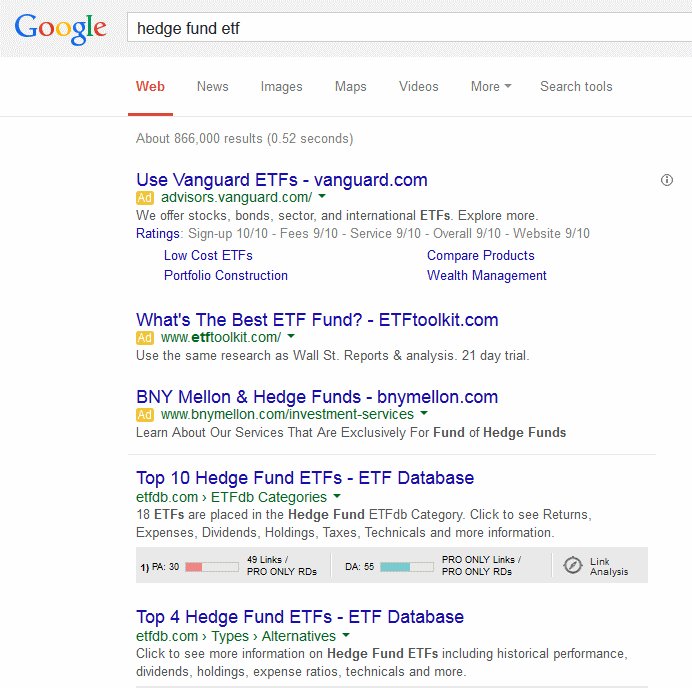When a person decides he wants to invest in an alternative form of investment, he typically goes through one of these four routes:
- Asks a trusted friend, family member, or coworker for advice.
- Asks someone he knows in the financial industry.
- Contacts the last investment company, including hedge funds, that he can remember.
- Go to Google for a search.
As far as getting found, options 1 and 2 are generally out of the question for most hedge funds.
Option 3 is mostly about luck, but you do have ways to game the system. Namely, you can market in a way that brands your hedge fund, thereby giving your hedge fund a higher probability of being remembered. Additionally, you can market more frequently, gaining more exposure. This latter option is expensive, but you can go about it in an inexpensive way through following up with your prospects.
Option 4 is a combination of SEO and copywriting. Today, we will be focusing on the latter aspect, copywriting. A later article will teach SEO.
All the Hedge Funds Are Shouting
Contents
Two places determine whether a Google-searcher decides to get more information about your hedge fund. The first is on the Google search results page, which follows:
The second is on your landing page, which is what the searcher sees after clicking on your link in Google.
Four Aspects of a Good On-Google Ad/Listing
A good listing on Google has the four following traits:
- It grabs their attention by connecting the searched keyword to the text in your listing.
- It offers value in exchange for a click.
- It’s enough for the searcher to stop reading the other listings.
- It begins a conversion that continues on the landing page.
Generally, I recommend the following, which works for pretty much any hedge fund: Offer free information that helps them determine how to choose the best provider of the keyword they searched for. For example, if the person searched for “emerging markets alternative investments,” write your listing so to say that the reader will get more information on choosing an emerging market alternative investment. This way, you stand out. While other hedge funds are saying, “Me, me, me! I’m the best emerging markets alternative investment,” you’ll actually be providing something of value.
Today, I will focus on helping your hedge fund fulfill the first three of the above four traits. The fourth trait will be a topic for a future article.
How a Hedge Fund Should Write Its Google Listing
A Google listing is composed of three parts:
- The title
- The metatext
- The URL
The Title
The title’s purpose is to draw people into reading the metatext. If you’re lucky, they’ll be so enticed by the title, they won’t even bother reading the metatext; they’ll go straight to clicking your link. In addition to drawing the reader in, a good title helps with your article’s SEO, allowing it to more easily appear at the top of Google.
A good title on Google is similar in traits to a good headline in the newspaper. When you read the paper, you look at the headlines to determine which articles you actually read. Think about how you determined what to read the last time you read a newspaper. Also think about how easy it is to differentiate between newspaper articles and ads.
As a quick experiment, go type in a keyword in Google and look at the results. Which would you click on and why?
Now, everyone is different. But the general rules for what people click on remain the same:
- The first and last words/phrases are the most important. Don’t put important information in the middle.
- Have the keyword someone in your title.
- Use one of the tried-and-true words to start your headline; my list appears below:
- How to…
- 5 Ways/Things/etc.… (or any other number)
- Why…
- Tricks for…
- Free…
- Tips for…
- Blog:
- The Best…
- A Great…
- How You…
You can turn practically any article’s title into one of the above. For example, “Trading with Historical Probabilities” becomes “How to Trade with Historical Probabilities”; “Long-Term Investment Strategies” becomes “6 Ways to Invest for the Future,” and so on…
The Metatext
The metatext is the one or two sentences that appear below the title. Good metatext should do three things:
- Contain the keyword.
- Be a call-to-action.
- Is under 160 characters.
Good Metatext Contains the Main Keyword
While what’s in the metatext won’t affect your SEO efforts in any way, putting the keyword in the metatext is still a good idea. Notice in the picture two sections above that Google finds the keywords in the metatext and converts them to bold text. This draws the reader to your article. Without any bold keywords in the metatext, the reader will be more likely to skip over your Google listing. And with good reason: If the reader is searching for “trade exists” and doesn’t see that word in your metatext, why would he want to click on your article? It’s quite likely, in this case, that your article doesn’t address trade exits in-depth.
Good Metatext Is a Call-to-Action
Good metatext should call the reader to act. The act in question here is to click into your website. A call-to-action is a set of phrases or sentences that make the reader want to click.
Writing a good call-to-action is an art that copywriters spend years studying. But in general, a good call to action should have the following:
- Elucidate the benefits of clicking.
- Use a strong actionable verb.
- Use time-sensitive words.
- Be reader-centric.
Of course, doing all this in the small space you’re allowed for the metatext is not easy, which is why so many people fail to succeed at this. This is good news for you – you’ll have a competitive edge.
Consider the following list of results for the search term “best trading platform” and their corresponding metatext:
None of these are good. Some do contain the benefits of clicking, such as the metatext in the nerdwallet link, which contains phrases such as, “the lowest priced” and “fees don’t add up quickly.” But it doesn’t contain the other aspects.
If I were competing with these companies, selling my own trading platform, I would write a metatext that goes something like:
“Get a 100% customizable trading platform, allowing you to identify the indicators significant to you. Start your free trial today.”
This metatext contains all four aspects I mentioned above:
- Benefits: “100% customizable,” “identify the indicators significant to you”
- Actionable verbs: “Get,” “Start”
- Time-sensitive: “today”
- Personal: “Get,” “you,” “your”
Good Metatext Is Under 160 Characters
If your metatext is over 160 characters, search engines will cut off your text, leaving you with that unsightly ellipses that you see in almost every search result (meaning very few people work on their metatext). Keep it short so that you can say everything you want without getting interrupted.
The URL
Your URL is important for three reasons:
- The keyword is still written as bold in the URL.
- The URL informs readers where they will end up.
- Your URL affects your SEO efforts.
The third reason is an issue for another article – it implicates how you build and structure your website. What you should worry about now is reasons 1 and 2.
Just as in the metatext, your keywords will appear as bold in the URL, which is why it’s important that your title’s main keyword also appears in the URL. Many publishing platforms, such as WordPress, will automatically make a URL for you based on your title. So, if you’re using WordPress, you don’t really need to do anything extra. Just double-check to ensure that all the important keywords appear in your URL (sometimes WordPress will cut out words to make your URL shorter).
Second, the URL tells readers where they will go after they click on your link. If readers are searching for “Australia interest rates” and see a URL seemingly unrelated to Australia or interest rates, they will be less likely to click. However, if the URL is something like economics.com.au/interest-rates, readers will see the link as a safe choice.
Getting your URL right isn’t hard. For most hedge funds, little work is necessary other than ensuring that your articles are titled correctly.


No Comment